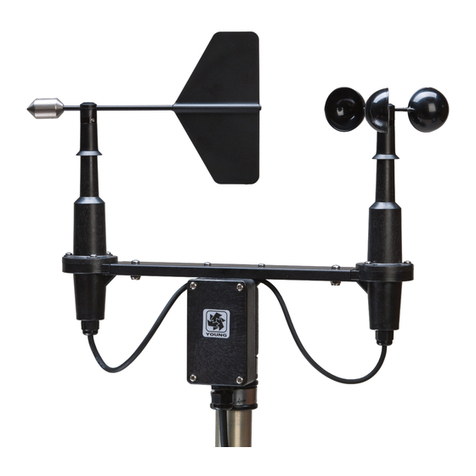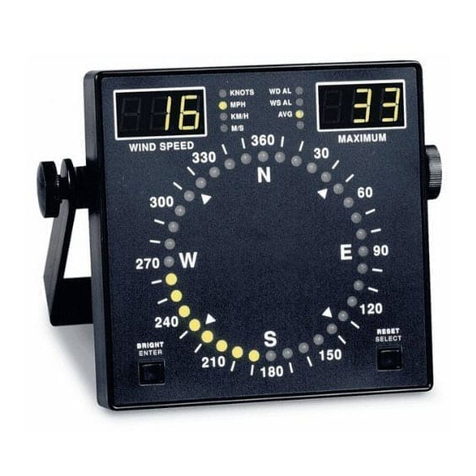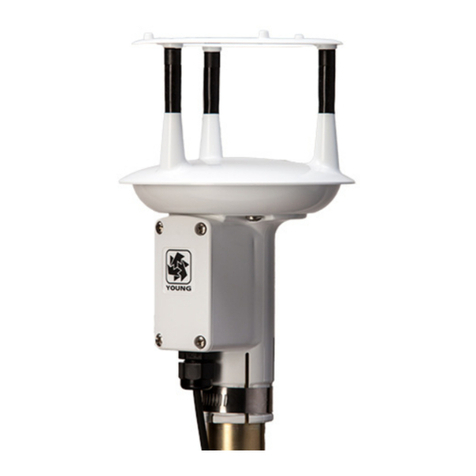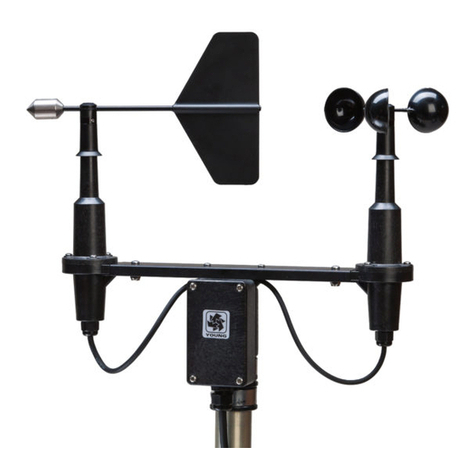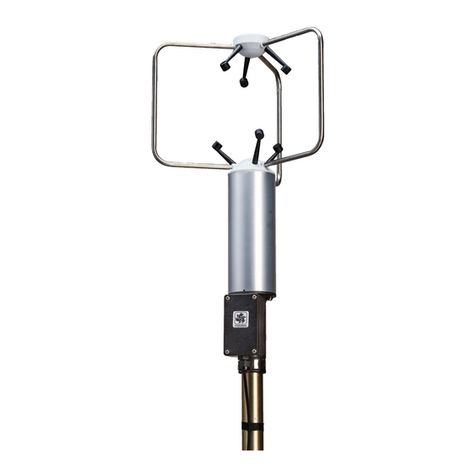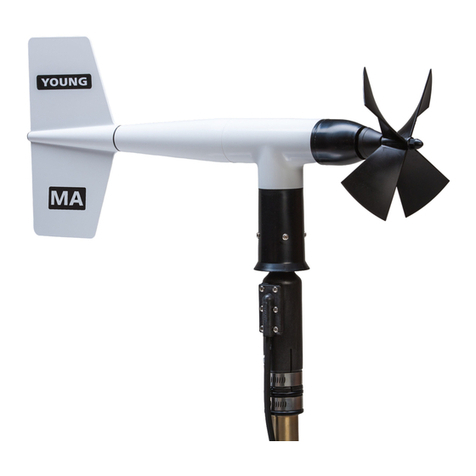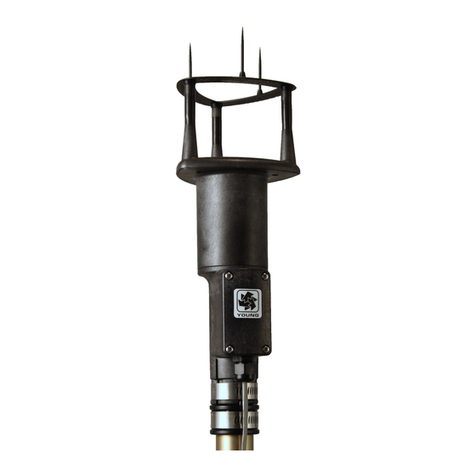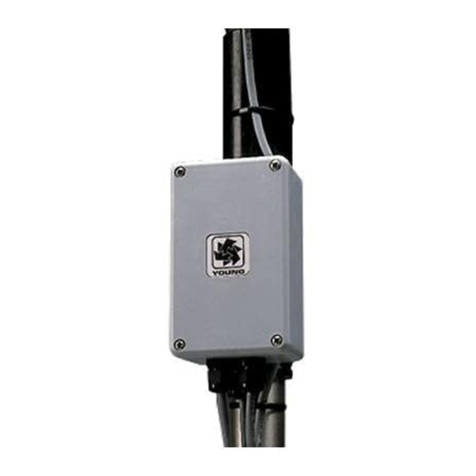
Page 2
86004-90(G
4.0 INSTALLATION
4.1 PLACEMENT
Proper instrument placement is important. Eddies from buildings,
trees, or other structures can inuence measurements. For most
applications, locate the sensor well above or upwind of obstructions.
As a general rule, air ow around a structure is disturbed to 2 times
the height of the structure upwind, 6 times the height downwind, and
up to 2 times the height of the structure above ground.
4.2 MOUNTING AND ALIGNMENT
Mount the sensor to standard 1-inch (IPS) pipe that has an outside
diameter of 1.34 inches (34 mm).
Most applications require aligning the sensor to geographic north
(0 degrees). In this orientation the sensor junction box faces
SOUTH (180 degrees). See the diagram in APPENDIX B.
4.2.1 Place orientation ring over pipe with guide pin up.
4.2.2 Place sensor mounting post over pipe.
4.2.3 Using the transducers as a sighting aid, align the
sensor with a feature on the horizon that represents
the proper orientation. After alignment, tighten the
mounting post band clamp to secure the position.
DO NOT OVER-TIGHTEN.
4.2.4 Slide the orientation ring up so its guide pin is fully
engaged in the sensor mounting post notch. Tighten the
orientation ring band clamp to secure its position.
DO NOT OVER-TIGHTEN.
If the sensor needs to be removed later, leave the orientation ring on
the pipe to preserve sensor alignment.
4.3 WIRING CONNECTIONS
Power supply voltage at the sensor +PWR and -PWR terminals must
be in the range of 22 to 26VDC to ensure proper heater operation.
When heaters are fully active, current consumption is 2.5A at 24VDC.
Use an adequately rated power supply. Limit power loss due to wire
resistance by using an adequate wire gauge and cable length. With
a 24VDC power supply and 18AWG power supply wire, cable lengths
up to 22m (75ft) could be used. Refer to WIRING DIAGRAMS in
APPENDIX A for details.
5.0 OPERATION
5.1 ANALOG OUTPUTS
As supplied, the sensor is congured for VOLTAGE OUTPUT, Wind
Speed and Wind Direction. The sensor may also be set up for 4-20
mA CURRENT output by changing internal settings. Details are in
section 6.0.
Analog VOLTAGE or 4-20mA CURRENT outputs may be
connected to a datalogger or other device such as a YOUNG 26800
Meteorological Translator. See APPENDIX A for connection details.
Analog outputs may be used simultaneously with RS-232 serial
connection. RS-485 serial output may not be used simultaneously
with analog outputs since they share connection terminals in the
junction box.
Analog outputs may be congured for either Polar (speed and
direction) or Cartesian (UV) output format.
For voltage output with cable lengths greater than 3m (10 ft.),
measure the signal differentially. Current output signals may be
measured single-ended.
5.2 USE WITH YOUNG WIND TRACKER DISPLAY
The factory default serial output format is RMYT which is compatible
with the YOUNG Model 06201 Wind Tracker display. Set the Wind
Tracker input to 'INP 09' and connect as shown in the Wiring diagram,
Fig A5, Appendix A. Note that jumpers need to be moved so the
RS-485 output is available at the connection terminals. Wind speed
and direction measurements appear on the Wind Tracker display.
See the Wind Tracker manual for display options and other details.
5.3 SERIAL OUTPUT FORMATS
Available serial output formats include RMYT, ASCII, ASCII polled,
and NMEA. The factory default format is RMYT for use with the
YOUNG Wind Tracker display. Other formats may be selected using
the 86SETUP program described in Section 6.0.
5.3.1 RMYT
RMYT is a 6-byte binary data format sent at 9600 baud using
RS -485 OUTPUT ONLY mode. This is the factory default serial format
for use with the YOUNG Model 06201 Wind Tracker.
5.3.2 ASCII
ASCII output format provides continuous wind measurement data in
text format at any of the available baud rates.
ASCII output appears either in POLAR (default) or CARTESIAN UV
format. With POLAR format, the wind speed threshold, wind speed
units, and resolution are user-selectable. With CARTESIAN the
wind threshold is ignored and wind speed units are always meters
per second (m/s).
ASCII POLAR FORMAT
a www.w ddd ss*cc<CR> Low resolution
a www.ww ddd.d ss*cc<CR> High resolution
where
a = Sensor address
www.ww = Wind speed
ddd.d = Wind direction
ss = Status code
* = Asterisk (ASCII 42)
cc = Checksum
<CR> = Carriage return (ASCII 13)
ASCII CARTESIAN (UV) FORMAT
a uu.uu vv.vv ss*cc<CR>
where
a = Sensor address
±uu.uu = U-axis wind speed (m/s)
±vv.vv = V-axis wind speed (m/s)
ss = Status code
* = Asterisk (ASCII 42)
cc = Checksum
<CR> = Carriage return (ASCII 13)
CHECKSUM is a two-character hexadecimal value (in printable
ASCII format) generated by taking the exclusive-or of all characters
up to the asterisk. STATUS CODE shows a non-zero value when
the sensor cannot acquire sufcient samples or a measurement
error has occurred.
5.3.3 ASCII POLLED
ASCII POLLED is like ASCII format described above except just
one serial output string is sent for each polling command received.
The polling command is Ma! where 'a' is the sensor address
(valid characters: 0-9, A-Z, a-z). The default address is '0'
(ASCII 48).






